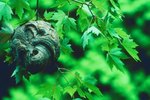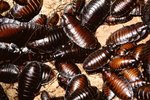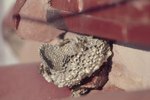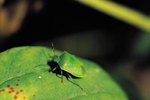
Yellow jackets, although harmful and sometimes deadly to humans, are beneficial to have near gardens, as they feed on common garden pests. These insects become more of an issue for humans in the late summer, when adult colonies are numbered in the thousands in preparation for winter. The life cycle of yellow jackets includes four stages: egg, larva, pupa and adult.
Egg
Newly fertilized queens are the only colony member to hibernate over the winter. In springtime, the queen yellow jackets emerge from hibernation and begin searching for a suitable place to build a nest and begin a new colony. Nests are typically built in places such as sheds, attics, timber piles, rock walls or in old rodent nests. The nests are constructed of saliva mixed with chewed wood or vegetation pulp. These newly constructed nests typically hold up to 45 cells, which act as rooms for the eggs. The queen protects her eggs until they hatch as larvae.
Larva and Pupa
Once the eggs hatch, the yellow jackets are in larval form. Resembling worms, the yellow jackets use this stage to gain nutrients as they begin to growing limbs and wings. The queen solely dedicates her time to feeding the larvae scavenged fish, meat and other insects until they pupate. After pupating, or developing adult features in protective pupal cases, they stay in this inactive transition for approximately three weeks until they emerge from their pupal cases as adults.
Adult
The first adults to emerge from their pupal cases are sterilized female yellow jackets. These females take over the role of feeding the larvae and the queen herself, as she continues to lay eggs over the summer. As more eggs mature and become adults, they assume other roles in the colony as adult workers. Roles such as searching for food, feeding the queen and defending the colony are fulfilled by the adult yellow jackets while the queen continues to lay eggs. Male wasps begin to mate with females and soon die, while new queens go off to hibernate. Winter conditions destroy the nests and yellow jackets must start anew in the spring.
Variations
By late summer, typical yellow jacket colonies can have more than 5,000 wasps. Warmer climate areas, such as Florida or Texas, often see increased numbers of colonies, as there are no freezing temperatures to destroy nests and food sources of yellow jackets. These colonies sometimes grow up to 100,000 adult workers. According to Clemson University, in 1991 a colony of 250,000 yellow jackets was found in Charleston County, South Carolina. The nest was believed to have been active for more than one year.
References
Resources
Photo Credits
-
Brand X Pictures/Brand X Pictures/Getty Images
Writer Bio
Amanda Williams has been writing since 2009 on various writing websites and blogging since 2003. She enjoys writing about health, medicine, education and home and garden topics. Williams earned a Bachelor of Science in biology at East Stroudsburg University in May 2013. Williams is also a certified emergency medical technician.




